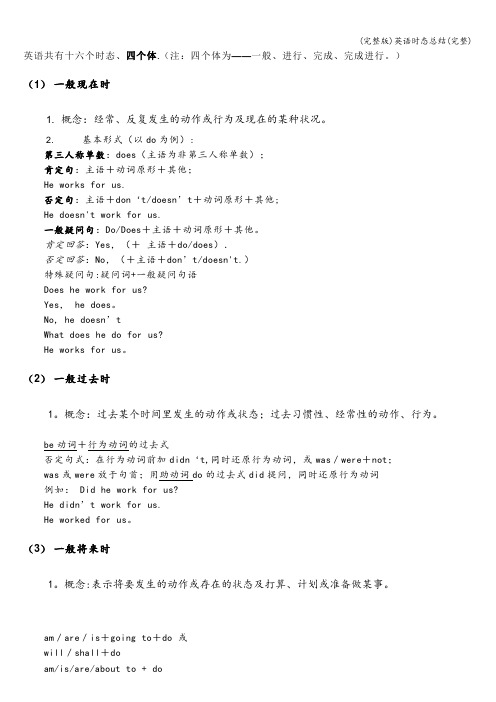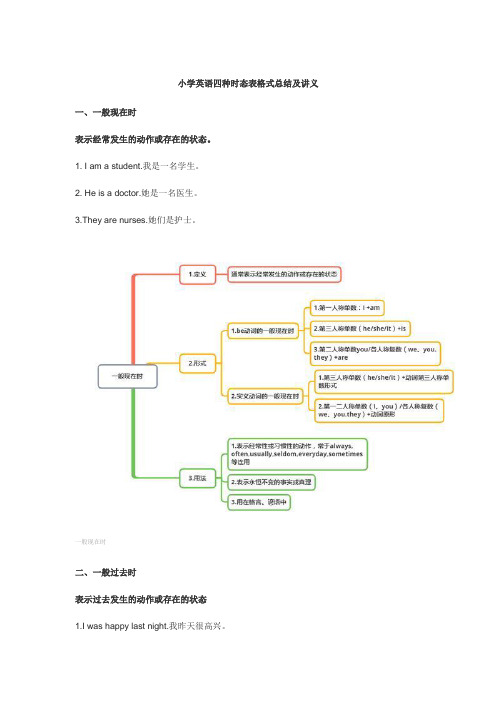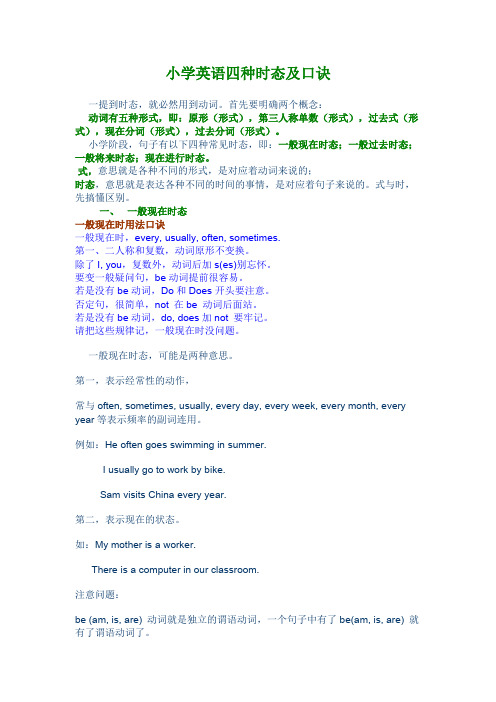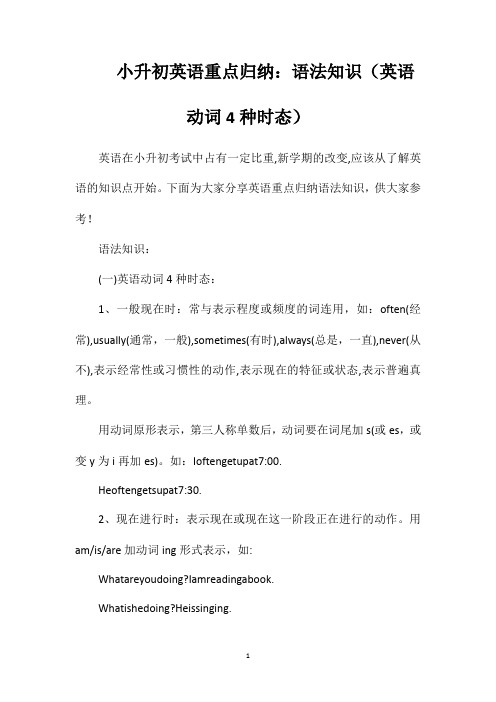(完整版)小学英语语法_四大时态(最新整理)
小学英语四种时态总结

小学英语四种时态总结英语语法中的时态是非常重要的一部分,正确使用时态可以使语言表达更加准确和清晰。
在小学英语学习阶段,学生们需要掌握四种基本的时态,它们分别是一般现在时、一般过去时、一般将来时和现在进行时。
下面将对这四种时态进行总结和归纳,希望能够帮助学生们更好地理解和掌握这些时态的用法。
一、一般现在时。
一般现在时表示的是经常性或习惯性的动作,或者是客观事实。
在句子中,一般现在时的动词形式不随主语的变化而变化,即动词用原形。
例如:1. I play football every Sunday.(我每个星期天都踢足球。
)。
2. She likes singing.(她喜欢唱歌。
)。
3. The sun rises in the east.(太阳从东方升起。
)。
二、一般过去时。
一般过去时表示的是发生在过去的动作或状态。
在句子中,一般过去时的动词形式通常是动词的过去式。
例如:1. I watched a movie last night.(昨晚我看了一部电影。
)。
2. They played basketball yesterday.(他们昨天打篮球。
)。
3. She lived in London for ten years.(她在伦敦住了十年。
)。
三、一般将来时。
一般将来时表示将来某个时间要发生的动作或状态。
在句子中,一般将来时通常使用助动词“will”或“shall”加上动词的原形。
例如:1. I will go to the park tomorrow.(我明天要去公园。
)。
2. She shall visit her grandparents next week.(她下周要去看望她的祖父母。
)。
3. We will have a party on Friday.(我们星期五要举办派对。
)。
四、现在进行时。
现在进行时表示现在正在进行的动作,或者是现阶段正在发生的动作。
在句子中,现在进行时的动词形式是“be”动词的现在分词形式。
小学英语四种时态总结

小学英语四种时态总结第一篇:小学英语四种时态总结小学英语四种时态总结1.一般现在时。
主要描述经常会发生的动作、状态或不变的真理。
句末常出现every day/week/year/Monday , in the morning, 句中常有always, usually, often, sometimes 组成:主语+be+名词(形容词)I am a student.He is tall.否定句:在be 后加notI am not a student.He is not tall.疑问句:be 动词提前到第一位。
Are you a student?Is he tall?Yes, I am./ No, I am not.Yes, he is./ No, he isn’t.主语+动词+地点+时间We go to school on Monday.He goes to the park on Sunday.否定句:主语+don’t/doesn’t’t+动词原形+地点+时间We don’t go to school on Monday.He doesn’t’t go to the park on Sunday.疑问句:在句首加do或doesDo you go to school on Monday? Yes, we do./ No, we don’t.Does he go to the park on Sunday? Yes, he does./ No, he doesn’t’t.动词单三变化:1.在原单词末尾加s , 如:like – likes2.单词以o, sh, ch, s, x 结尾加es, 如:go – goes3.单词末尾为辅音+y结尾去y加ies 如:study-studies 2.现在进行时:主要叙述正在发生的事情。
句末常出现now, 句首常出现look, listen 组成:主语+be +动词ing形式I am reading English.They are swimming.He is playing football.否定句:在be后加not I am not reading English.They are not swimming.He is not playing football.疑问句:将be 放到第一位。
小学英语常见四种时态

小学英语常见四种时态一、一般现在时:动词+S1.特殊情况:(1)sh 、ch、o结尾的+es例如:wash_(wash es) watch_(watch es) do_(do es)(2)(2)以y结尾的:把y变成i +es例如:study——(stud ies)2.用单词的正确形式填空:1)Mike does (do) his homework every day.2)My grandma watches (watch)TV every day.3)I often listen (listen)to the misic in the evening.二、现在进行时:动词+ing1.特殊情况:(1)以e结尾,去掉e,+ing例如:make(making) come(coming) dance(dancing)(2)双写结尾字母:sit(si tt ing)swim(swi mm ing) run(ru nn ing)2.用单词的正确形式填空:(1)look! li hua and Mike are singing(sing) now.(2)The small bear is climbing(climb)the tree.(3)My brother is making(make) kites.(4)Lily is sitting (sit) on the chair.三、一般过去时:动词+ed1.特殊情况:(1)有e结尾的,直接+ d例如:like(liked) live(lived)(2)有y结尾的,把y变成+ed 例如:cry(cried)study(studied)(3)不规则变化eat(ate) get(got) see(saw) spend(spent) do(did) teach(taught) win(won) write(wrote) buy (bought) swim(swam)go(went) meet(met) are(were) is(was) am(was)2.用单词的正确形式填空:(1).Did you water the flower yesterday.(2)L i Hua went(go) for a walk last Sunday.(3)M ike didn’t finish (finish)his homework yesterday.(4)I picked apples on the tree last month.四、一般将来时:(1)Shall/will +动词原形(shall只能用于第一人称I /we shall)(2)be going to +动词原形(表示打算做什么)be going to+地点(表示准备去)例如:1.I am going to see a film tomrrow.2There will be a party in our school3.Mike will visit his grandpa next week.。
(完整版)英语时态总结(完整)

英语共有十六个时态、四个体.(注:四个体为——一般、进行、完成、完成进行。
)(1)一般现在时1. 概念:经常、反复发生的动作或行为及现在的某种状况。
2. 基本形式(以do为例):第三人称单数:does(主语为非第三人称单数);肯定句:主语+动词原形+其他;He works for us.否定句:主语+don‘t/doesn’t+动词原形+其他;He doesn't work for us.一般疑问句:Do/Does+主语+动词原形+其他。
肯定回答:Yes,(+主语+do/does).否定回答:No,(+主语+don’t/doesn't.)特殊疑问句:疑问词+一般疑问句语Does he work for us?Yes, he does。
No, he doesn’tWhat does he do for us?He works for us。
(2)一般过去时1。
概念:过去某个时间里发生的动作或状态;过去习惯性、经常性的动作、行为。
be动词+行为动词的过去式否定句式:在行为动词前加didn‘t,同时还原行为动词,或was/were+not;was或were放于句首;用助动词do的过去式did提问,同时还原行为动词例如: Did he work for us?He didn’t work for us.He worked for us。
(3)一般将来时1。
概念:表示将要发生的动作或存在的状态及打算、计划或准备做某事。
am/are/is+going to+do 或will/shall+doam/is/are/about to + doam/is/are to + do;一般将来时的表达方法be going to +动词原形be +不定式,be to+动词原形,be about to +动词原形be able to +不定式be about to+动词原形will + 动词原形;例如:He is going to work for us。
小学英语四种时态表格式总结及讲义

小学英语四种时态表格式总结及讲义一、一般现在时表示经常发生的动作或存在的状态。
1. I am a student.我是一名学生。
2. He is a doctor.她是一名医生。
3.They are nurses.她们是护士。
一般现在时二、一般过去时表示过去发生的动作或存在的状态1.I was happy last night.我昨天很高兴。
2.You were great in the exam.你考试考得不错。
3.We met a girl at the gate.在门口我们见到了一个女孩。
一般过去式时三、一般将来时通常表示现在还有发生,但即将发生的事情或动作。
1.I shall be there in 5 minutes.我五分钟后会到那里。
2.We will go to the park this night.我们今天晚上将去公园。
3.Ken is gonging to have a bath.Ken要去洗澡了。
一般将来时四、现在进行时表示正在进行或发生的动作1.I am eating now.我正在吃东西。
2.He is singing now.他正在唱歌。
3.They are playing now.他们正在玩。
4.We are writing a book this month.我们这个月正在写一本书。
现在进行时以上是小学阶段常见的四大时态,除了以上在使用时还需注意以下几点:1. I am=I'm he is=he's she is=she's it is=it's we are=we're you are=you'reI shall/I will=I'll you will=you'll she will=she'll it will=it'll2.表示将来时时只有第一人称(I/we)后面接shall,表示我(们)将要……,3.当征求某人意见时一般使用shall I/shall we。
(完整版)小学英语四种时态及口诀

小学英语四种时态及口诀一提到时态,就必然用到动词。
首先要明确两个概念:动词有五种形式,即:原形(形式),第三人称单数(形式),过去式(形式),现在分词(形式),过去分词(形式)。
小学阶段,句子有以下四种常见时态,即:一般现在时态;一般过去时态;一般将来时态;现在进行时态。
式,意思就是各种不同的形式,是对应着动词来说的;时态,意思就是表达各种不同的时间的事情,是对应着句子来说的。
式与时,先搞懂区别。
一、一般现在时态一般现在时用法口诀一般现在时,every, usually, often, sometimes.第一、二人称和复数,动词原形不变换。
除了I, you,复数外,动词后加s(es)别忘怀。
要变一般疑问句,be动词提前很容易。
若是没有be动词,Do和Does开头要注意。
否定句,很简单,not 在be 动词后面站。
若是没有be动词,do, does加not 要牢记。
请把这些规律记,一般现在时没问题。
一般现在时态,可能是两种意思。
第一,表示经常性的动作,常与often, sometimes, usually, every day, every week, every month, every year等表示频率的副词连用。
例如:He often goes swimming in summer.I usually go to work by bike.Sam visits China every year.第二,表示现在的状态。
如:My mother is a worker.There is a computer in our classroom.注意问题:be (am, is, are) 动词就是独立的谓语动词,一个句子中有了be(am, is, are) 就有了谓语动词了。
句子中不能同时出现两个谓语动词。
不少同学经常出这样的错误:The boy is often eats hamburgers.(错)应改为:The boy often eats hamburgers.二、现在进行时态正在进行时态口诀现在分词用途多,进行时态不用说。
小升初英语重点归纳语法知识(英语动词4种时态)

小升初英语重点归纳:语法知识(英语动词4种时态)英语在小升初考试中占有一定比重,新学期的改变,应该从了解英语的知识点开始。
下面为大家分享英语重点归纳语法知识,供大家参考!语法知识:(一)英语动词4种时态:1、一般现在时:常与表示程度或频度的词连用,如:often(经常),usually(通常,一般),sometimes(有时),always(总是,一直),never(从不),表示经常性或习惯性的动作,表示现在的特征或状态,表示普遍真理。
用动词原形表示,第三人称单数后,动词要在词尾加s(或es,或变y为i再加es)。
如:Ioftengetupat7:00.Heoftengetsupat7:30.2、现在进行时:表示现在或现在这一阶段正在进行的动作。
用am/is/are加动词ing形式表示,如:Whatareyoudoing?Iamreadingabook.Whatishedoing?Heissinging.3、一般将来时:常与表示将来的时间连用,如:tomorrow,nextweek,nextyear等,表示将要发生的动作或情况。
用am/is/are加goingto形式表示,如:Whatareyougoingtodotomorrow?I;;mgoingtorideahorse.用will加动词原形表示,如:WhatwillyoudonextSunday?Iwillgoshopping.用am/is/are加动词ing形式表示,如:Whatareyoudoingtomorrow?I;;mgoingbowling.4、一般过去时:经常与表示过去的时间连用,如:yesterday,lastnight 等,表示过去某时发生的动作或情况。
动词要用动词的过去式。
如:Whowasfirst?Kenwasfirst.Wherewereyouyesterday?Iwasathome.Whatdidyoudoyesterday?Iwenttoschool.以上是为大家分享的英语重点归纳语法知识,希望对大家有所帮助!2017精选小升初英语知识点讲解:名词备战小升初英语名词复数规则语法考点。
小学英语四种时态整理

动词变化规则
Be动词口诀:我用am你用are,is连着 她他它,单数is复数are,要想学好牢 记他。变否定更容易。be后not莫忘 记,变疑问,往前提,句尾问好莫丢弃 。什么问什么答,你问我答
动词+s的变化规则(动词三单)
1.直接加s,
如:cook-cooks, milk-milks
2.以s. x. sh. ch. o结尾 ,
妖镜,后面动词现原形)
be + doing
一般疑问句:Be提前 变否定就:Be 后+not is not= isn't are not=aren't I am not =I'm not
be 动词: Be(was/were)+其他
was/were is/am-was are-were was not=wasn't were not=weren't
陈述句: We will go to Beijing tomorrow. 否定句: We won't go to Beijing tomorrow. 一般疑问句及其答语: Will you go to Beijing tomorrow ? Yes,she will../No,she won't.
be找助动词。
一般疑问句:Do 在前 非三单,动词为原形 Do+主语+动词原形+其它 ?
变否定就:动词前+don't
实义动词: 主语+实义动词(+其 它)
实义动词: 主语+实义动词(+其 它)
一般疑问句:Does在前
主语为第三人称单数 (he, she,it)时,要 在动词后加"-s"或"es"。
- 1、下载文档前请自行甄别文档内容的完整性,平台不提供额外的编辑、内容补充、找答案等附加服务。
- 2、"仅部分预览"的文档,不可在线预览部分如存在完整性等问题,可反馈申请退款(可完整预览的文档不适用该条件!)。
- 3、如文档侵犯您的权益,请联系客服反馈,我们会尽快为您处理(人工客服工作时间:9:00-18:30)。
四大时态复习1. 一般现在时(1)一般现在时的构成(肯定句)☆ be动词:主语+be(am,is,are)+其它。
如:I am a boy.我是一个男孩。
☆行为动词:主语+行为动词(+其它)。
如:We study English.我们学习英语。
☆当主语为第三人称单数(he, she,it)时,要在动词后加"-s"或"-es"。
如:Mary likes Chinese.玛丽喜欢汉语。
(2)一般现在时的变化☆ . be动词的变化。
[否定句]:主语+ be + not +其它。
如:He is not a worker.他不是工人。
[一般疑问句]:Be +主语+其它。
如:-Are you a student? -Yes. I am. / No, I'm not.[特殊疑问句]:疑问词+一般疑问句。
如:Where is my bike?☆ .行为动词的变化。
[否定句]:主语+ don't( doesn't ) +动词原形(+其它)。
如:I don't like bread.当主语为第三人称单数时,要用doesn't构成否定句。
如:He doesn't often play.[一般疑问句]:Do( Does ) +主语+动词原形+其它。
如:- Do you often play football?- Yes, I do. / No, I don't.当主语为第三人称单数时,要用does构成一般疑问句。
如:- Does she go to work by bike? - Yes, she does. / No, she doesn't.[特殊疑问句]:疑问词+一般疑问句。
如:How does your father go to work?*动词+s的变化规则1.一般情况下,直接加-s,如:cook-cooks, milk-milks2.以s. x. sh. ch. o结尾,加-es,如:guess-guesses, wash-washes, watch-watches, go-goes 3.以“辅音字母+y”结尾,变y为i, 再加-es,如:study-studies2. 现在进行时(1)一般现在时的构成:be(am,is, are)+ 动词的ing形式。
如:I am reading. 我正在读书(2)现在进行时的否定句在be后加not,即be(am,is, are) + not + 动词的ing形式。
如:She is not doing her homework now. 她现在没有做作业。
(3)现在进行时的一般疑问句把be动词调到句首,即Be(am,is, are) + 人+ 动词ing形式。
如:Are you drinking milk now? 你现在在喝牛奶吗?(4)现在进行时的特殊疑问的基本结构为:疑问词+ be + 人+ 动词ing?如:Where are you going? 你现在去哪?但who当主语时其结构为:Who + be + 动词ing?如:Who is talking to you? 谁在和你说话?*动词加ing的变化规则1.一般情况下,直接加ing,如:cook-cooking2.以不发音的e结尾,去e加ing,如:make-making, taste-tasting3.如果末尾是一个元音字母和一个辅音字母,双写末尾的辅音字母,再加ing,如:run-running, stop-stopping3. 一般将来时(1)一般将来时基本结构:①be going to + do(动词原形);②will+ do(动词原形). (2)[否定句]:在be动词(am, is, are)后加not或情态动词will后加not成won’t。
结构为:be(am, is, are) + not + 动词原形will not + 动词原形(will not = won’t)例如:①I’m going to have a picnic this afternoon.→I’m not going to have a picnic this afternoon.②I will go shopping this weekend.→I will not go shopping this weekend.= I won’t go shopping this weekend.(3)[一般疑问句]:be或will提到句首,some改为any, and改为or,第一二人称互换。
例如:①We are going to go on an outing this weekend.→ Are you going to go on an outing this weekend?② I will play football tomorrow afternoon.→ Will you play football tomorrow afternoon?(4)[特殊疑问句]①问人用Who例如:I’m going to New York soon. →Who’s going to New York soon.②问干什么用What …do.例如:My father is going to watch a race with me this afternoon.→What is your father going to do with you this afternoon.③问什么时候用When.例如:She’s going to go to bed at nine. →When is she going to bed?4. 一般过去时(1).[肯定句] be动词在一般过去时中的变化:☆ am 和is在一般过去时中变为was。
(was not=wasn’t)☆ are在一般过去时中变为were。
(were not=weren’t)行为动词在一般过去时的句子中要变成过去式(一般是在句子后面加ed)(2)[否定句]:be动词变成was not(wasn’t) 或were not (weren’t)如:He wasn’t a teacher two years ago.didn’t +动词原形如:Jim didn’t go home yesterday.(3)[一般疑问句]有be动词的一般疑问句把was或were调到句首。
如:Were you a teacher two years ago?句中没有be动词的一般过去时的句子,在句首加did,句子中的动词过去式变回原形。
如:Did Jim go home yesterday?(4)[特殊疑问句]:①疑问词+did+主语+动词原形?如:What did Jim do yesterday?②疑问词是who时:疑问词+动词过去式?如:Who went to home yesterday?* 动词过去式变化规则:☆.一般在动词末尾加-ed,如:pull-pulled, cook-cooked☆.结尾是e加d,如:taste-tasted☆.末尾只有一个元音字母和一个辅音字母的重读闭音节,应双写末尾的辅音字母,再加-ed,如:stop-stopped☆.以“辅音字母+y”结尾的,变y为i,再加-ed,如:study-studied☆.不规则动词过去式:am,is-was, are-were, do-did, see-saw, say-said, give-gave, get-got, go-went, come-came, have-had, eat-ate, take-took,run-ran, sing-sang, put-put, make-made, read-read, write-wrote, draw-drew, drink-drank, fly-flew, ride-rode,speak-spoke, sweep-swept, swim-swam, sit-sat【随堂练习】一、写出下列动词的第三人称单数drink ________ go _______ stay ________ make ________ look _________ have_______ pass_______ carry ____ come________ watch______ plant_______ fly ________study_______ brush________ do_________ teach_______二、按照要求改写句子1. Daniel watches TV every evening.(改为否定句)___________________________________________________2. I do my homework every day.(改为一般疑问句,作否定回答)________________________________________________________3. She likes milk.(改为一般疑问句,作肯定回答)___________________________4. I like taking photos in the park.(对划线部分提问)________________________________________________________5. John comes from Canada.(对划线部分提问)___________________________________________________三.写出下列动词的现在分词:play________ run__________ swim _________make__________ go_________ like________ write________ _ski___________ read________ have_________ sing ________ dance_________ put_________ see________ buy _________ love____________ live_______ take_________ come ________ get_________ stop_________ sit ________ begin________ shop___________四、句型转换:1. They are doing housework .(改成否定句)_____________________________________________________________2.The students are cleaning the classroom . ( 改一般疑问句并作肯定和否定回答)__________________________________________________________________________________________________________________________________3.I’m playing the football in the playground .(对划线部分进行提问)_________________________________________________________________4.Tom is reading books in his study . (对划线部分进行提问)_________________________________________________________________五.填空。
